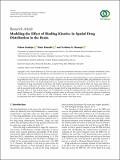| dc.description.abstract | A 3-dimensional mathematical model is developed to determine the effect of drug binding kinetics on the spatial distribution of a
drug within the brain. The key components, namely, transport across the blood-brain barrier (BBB), drug distribution in the brain
extracellular fluid (ECF), and drug binding kinetics are coupled with the bidirectional bulk flow of the brain ECF to enhance the
visualization of drug concentration in the brain. The model is developed based on the cubical volume of a brain unit, which is a
union of three subdomains: the brain ECF, the BBB, and the blood plasma. The model is a set of partial differential equations
and the associated initial and boundary conditions through which the drug distribution process in the mentioned subdomains is
described. Effects of drug binding kinetics are investigated by varying the binding parameter values for both nonspecific and
specific binding sites. All variations of binding parameter values are discussed, and the results show the improved visualization
of the effect of binding kinetics in the drug distribution within the brain. For more realistic visualization, we suggest
incorporating more brain components that make up the large volume of the brain tissue. | en_US |

